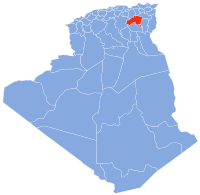Lambaesis
 Arch of Septimius Severus | |
| Alternative name | Lambaesa (Lambese) |
|---|---|
| Location | Tazoult, Batna Province, Algeria |
| Coordinates | 35°29′20″N 06°15′21″E / 35.48889°N 6.25583°E |
| Type | Settlement |
| History | |
| Periods | Roman Empire |
| Site notes | |
| Condition | In ruins |
Lambaesis (Lambæsis), Lambaisis or Lambaesa (Lambèse in
History
Lambaesa was founded by the Roman military. The camp of the third legion (Legio III Augusta), to which it owes its origin, appears to have been established between AD 123–129, in the time of Roman emperor Hadrian, whose address to his soldiers was found inscribed on a pillar in a second camp to the west of the great camp still extant. However, other evidence suggests it was formed during the Punic Wars.[citation needed]
The town is built 622 m above sea level in the plain and on the spurs of the Djebel Asker[2]
By AD 166 mention is made of the
III Augusta was disbanded by Gordian III and the legionaries dispersed among the North African provinces. But the legion was restored in the AD 250s by Valerianus and Gallienus and from then on the legion was known as Augusta Restituta. Its final departure did not take place till after AD 392 (the town soon afterwards declined).


Indeed, under
Subsequently, however, Emperor
The Byzantines occupied Lambaesis and vicinity from the sixth century but around AD 683 the Arabs conquered the area, naming what remained of the city Bar-el-Molouk in the 10th century.
Ecclesiastical history
Lambaesis was an episcopal see during late Ancient times as part of the Roman province of Numidia.[3] For such an important town, its bishopric is surprisingly absent from the historical record. Lambaesis did not send a representative to the Council of Nicaea[4] nor Chalcedon[5] and is not mentioned by LeQuinn .[6]
Saint
Titular see
The extinct diocese was nominally restored as a
It has had the following incumbents, of the lowest (episcopal) rank :
- Jan Dembowski (1759.09.24 – 1790)
- Hieronim Stojnowski (Stroynowski) (1804.08.20 – 1814.09.26)
- Mateo José González Rubio (1836.02.01 – 1845.06.15)
- Eduardo Vásquez, Dominican Order (O.P.) (1853.12.30 – 1856.12.12)
- Thomas O’Callaghan, O.P. (1884.06.29 – 1886.12.03)
- Jean-Marie-Michel Blois (衛忠藩), Shenyang瀋陽 (China) (1924.12.03 – 1946.04.11), later promoted first Metropolitan Archbishop of Shenyang 瀋陽 (China) (1946.04.11 – 1946.05.18)
- James Moynagh, S.P.S. (1947.06.12 – 1950.04.18)
- Vincenzo Maria Jacono (1950.09.08 – 1955.02.02)
- Thomas Edward Gill (1956.04.11 – 1973.11.11)
- John Stephen Cummins (1974.02.26 – 1977.05.03)
- John Joseph Paul (1977.05.17 – 1983.10.14)
- Cardinal Cardinal-Priestof S. Sisto (2001.02.21 [2001.05.20] – ...)
- Michel Pierre Marie Mouïsse(2000.03.10 – 2004.03.05)
- Carlo Roberto Maria Redaelli (2004.04.08 – 2012.06.28), (later Archbishop)
- David Prescott Talley (2013.01.03 – 2016.09.21), Auxiliary Bishop of Atlanta(USA)
- Marc Pelchat (2016.10.25 – ...), Auxiliary Bishop of Québec(Canada)
Remains
The remains of the Roman town, and more especially of the Roman camp, in spite of wanton vandalism, are among the most interesting ruins in northern Africa.

The ruins are situated on the lower terraces of the
Of the temple of

Behind this building (which was roofed), is a large court giving access to other buildings, one being the
Over 2500 inscriptions relating to the camp have been deciphered. In a museum in the village are objects of antiquity discovered in the vicinity.
About 2 miles (3.2 km) south of Lambessa are the ruins of Markuna, the ancient Verecunda, including two triumphal arches.
-
Mosaic at Lambaesis
-
Groma, gate to the principia
-
Amphitheatre at Lambaesis
-
Ruins at Tazoult
-
Roman Bridge at Tazoult
-
Roman Era Arch
-
Arch of Septimius Severus 1850s
Notes
- ^ René Cagnat. Lambèse. Lerous, Paris 1893 (Original in French)
- ^ Stilwell, Richard, ed. (1976). The Princeton Encyclopedia of Classical Sites. Retrieved May 19, 2021.
- ISBN 0-8006-1931-5.
- ^ Heinrich Gelzer, Patrum Nicaenorum nomina Latine, Graece, Coptice, Syriace, Arabice, Armeniace. (In aedibus B.G. Teubneri, 1995 ).
- ^ Richard Price, Michael Gaddis, The Acts of the Council of Chalcedon, Volume 1 (Liverpool University Press, 2005).
- ^ Michel Lequien, Oriens christianus in quatuor Patriarchatus digestus', Paris 1740, Vol. I.
- ^ Dictionnaire d’Archeologie Chretienne et de Liturgie, volume 8 columns 1067-1075
- ISBN 0415238498.
- ^ René Cagnat. Musée de Lambèse. Leroux, Paris 1895 (Original in French)
References
- S. Gsell, Les Monuments antiques de l'Algerie (Paris, 1901) and L'Algérie dans l'antiquité (Algiers, 1903);
- L. Renier, Inscriptions romaines de l'Algérie (Paris, 1855);
- Gustav Wilmann, "Die rm. Lagerstadt Afrikas", in Commentationes Phil. in honoreni Th. Mommseni (Berlin, 1877);
- Sir L. Playfair, Travels in the Footsteps of Bruce (London, 1877);
- A. Graham, Roman Africa (London, 1902).
This article incorporates text from a publication now in the public domain: Chisholm, Hugh, ed. (1911). "Lambessa". Encyclopædia Britannica. Vol. 16 (11th ed.). Cambridge University Press. pp. 109–110.
Source and External links
- Joint Anglo-Algerian excavations of Lambaesis — archaeological team since 1985.
- GigaCatholic with titular incumbent biography links
- Archeorom3.site: Photos from Lambaesis Archived 2004-12-19 at the Wayback Machine
- Images of Lambaesis (Tazoult) in Manar al-Athar digital heritage photo archive
See also
- Legio III Augusta
- Timgad
- Djémila
- Cirta
- Caesarea
- Auzia
- Rapidum










